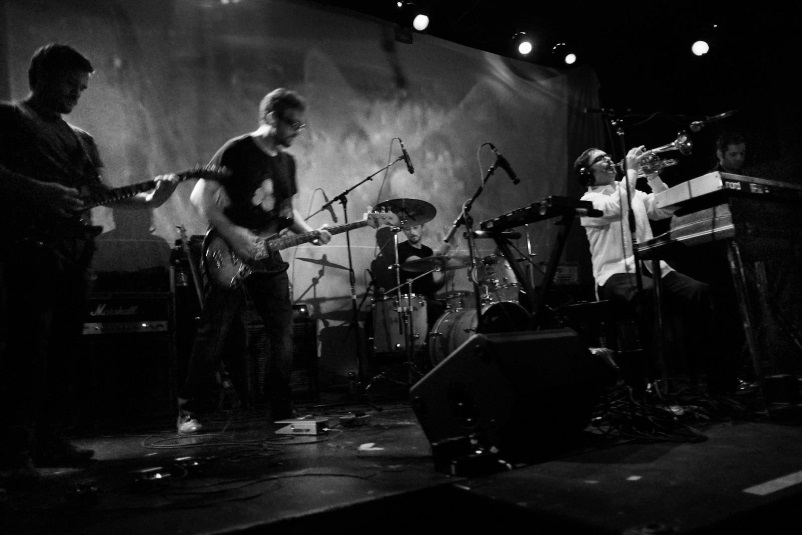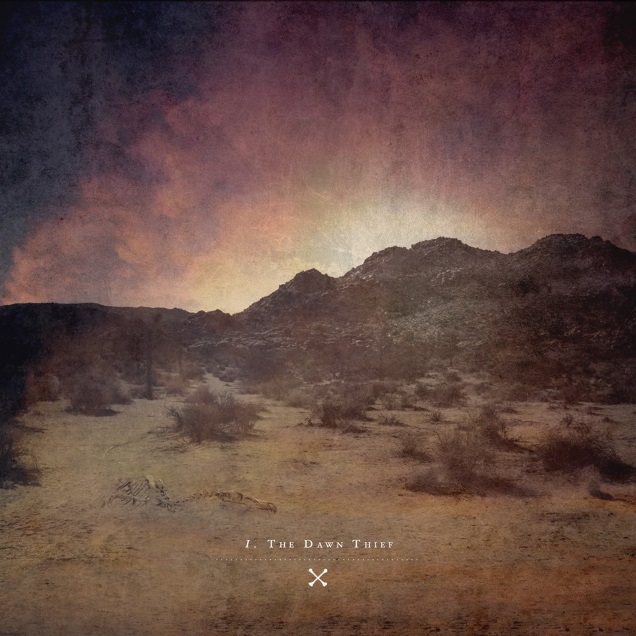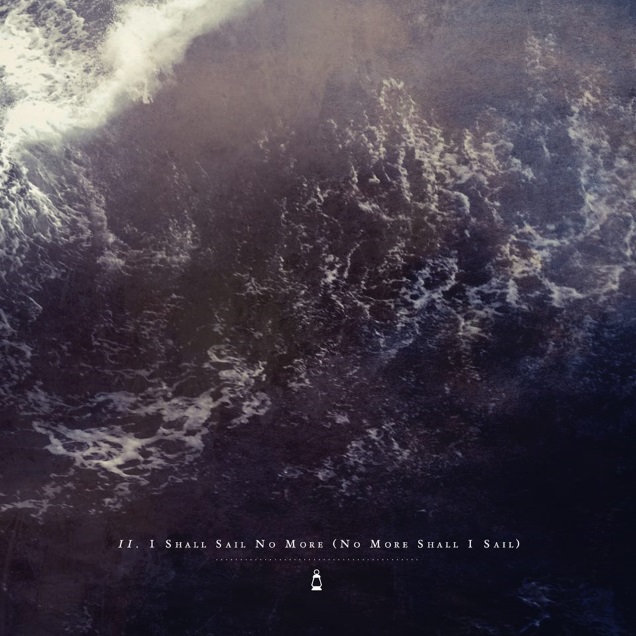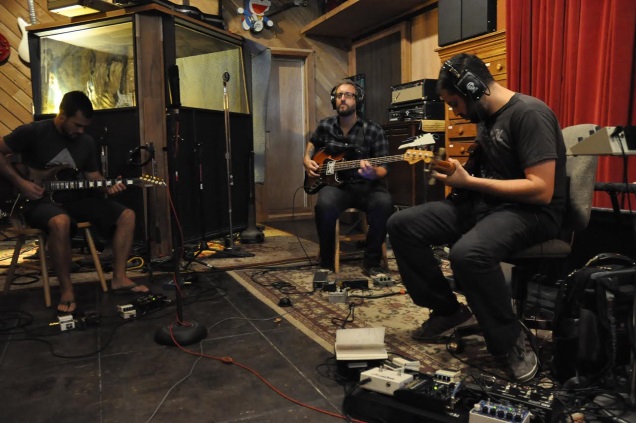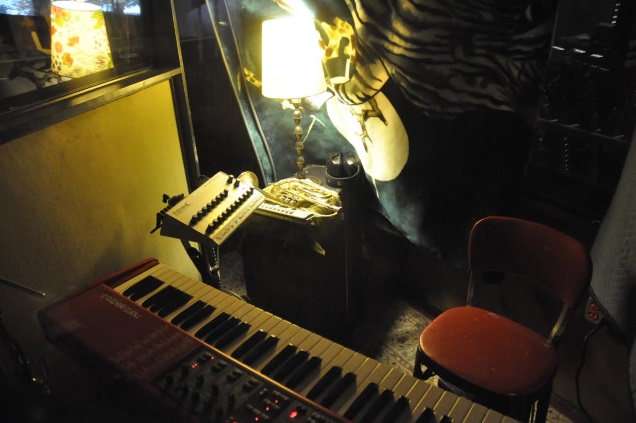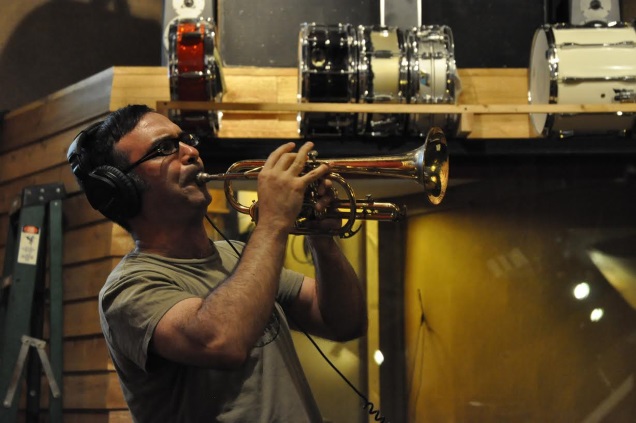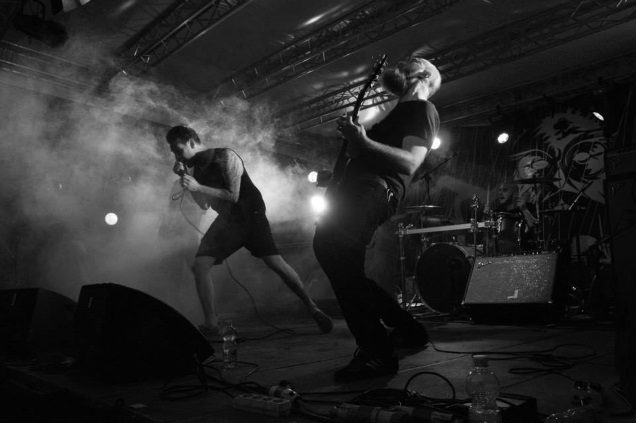If music can paint pictures in the listener’s mind, then this must be one of the most interesting masterpieces in the world of cinematic and instrumental music. WHALE FALL come from Los Angeles, California and have recently unveiled their second album called “The Madrean”, an eight-song instrumental story of the Madrean Region of the American Southwest. Accompanied by the amazing artwork (individual visuals for each track by Jordan W. Lee), this intriguing effort continues the sonic progression of their previous work, leaving the listener to relax in the atmospheric heaviness and more melancholic moments that prevail throughout the entire musical journey. A record of this quality should have many talking about.
Studio photos come from the recording sessions for The Madrean held in October 2013 at The Hobby Shop recording studios in the Highland Park neighborhood of Los Angeles.
Hey there guys! Thanks so much for taking some time with IDIOTEQ. How are you? Are you ready to unveil the darkest secrets of Whale Fall?
We are well, thank you! Pleased to be speaking with you. The ocean floor to which whales fall is certainly a dark and secret place, and we are ready to dive deep.
Cool. Let’s start digging then :)
You called your new album “The Madrean” “an eight-song instrumental story of the Madrean Region of the American Southwest”. Tell us more about the origins of this concept and the whole idea behind this project.
It’s important to say from the outset that the concept of the album was not preconceived. It came to us with time. Truthfully it was not until the recording was finished that the idea of The Madrean was born. This speaks to our process, which is an organic one. We create in a fairly spontaneous way, from what can be assumed to be a dark and secret but in any case non-premeditated place, and things take shape. The songs themselves gain structure over time, and when we are lucky a story starts to form. Tokle has a particular knack for imagining a visual and even narrative story suggested by the music. For “I Shall Sail No More (No More Shall I Sail)” he saw in his mind’s eye an old man with his cat on a ship which gets caught it a storm, catches fire, and sinks. While rehearsing “Overpass LA,” a few of us including Dave had a shared image of a lone trumpeter beneath a freeway overpass in the wee hours. One by one, the scenes developed, and started to tell a story of sorts, not one with a script, but more an ethos of time and place and feeling.
The geographic metaphor was irresistible in the sense of being automatic. Each song started out as an island, and these islands formed an archipelago, and by the time the record was finished they had coalesced into more of a continuous land mass. It turns out there is something called the Madrean Sky Archipelago, or Madrean Sky Islands, or just Madrean Archipelago (depending on the source). They are a set of woodlands found at higher elevations, surrounded by lower-elevation deserts, in New Mexico, Arizona, and Northern Mexico. The Madrean region itself includes these places as well as parts of California and the Southwestern U.S. The Madrean as a concept (be it place, protagonist, or otherwise) really seemed to fit, especially since between the five of us all we have roots in this region of the country, and since, not coincidentally, many of the sounds on the record evoke big skies, mountains, and Spaghetti Westerns, though not in the sense one might normally assume.
Amazing! I love the idea! What are the main philosophies that underpin the message of the album?
We’re not sure we could characterize it as philosophies or message in the usual sense (too prescriptive). If we expand those definitions, though, or maybe substitute with the words “themes” or “meanings,” we have a few of our own and, more importantly, we hope each listener will come up with his or her own meanings and interpretations. In other words, we hope that this stirs people up in a way that will be unique for each person.
In terms of the themes and meanings we ourselves have identified, there is a theme of progression from darkness to light, or from heaviness to lightness (the other sense of “light”). As in life, however, these are not linear progressions but fluctuations which may or may not have a gradual trend. This can be heard within individual tracks, such as “Tahquitz,” which starts slow, thick, and lumbering, and ends in a dance party, as well as from one track to the next, with the lonely dirge-iness (if that could be a word) of the first section of “Heart Space” eventually morphing over the course of two tracks into the warm and cheerful fireside romp of the last section of “The Madrean.” The LP album artwork by Jordan Lee, which we are thrilled with, has an imbedded progression of darkness to light if you look closely. (However, we are all having to wait a while for that pleasure as record-pressing plants are swamped these days.)
Another theme is sort of a “lone protagonist facing the perils and promise of nature” tale. Again, the LP packaging hints at this with its classic novel appearance. Think the old man in “I Shall Sail No More (No More Shall I Sail)” as described above, or “El Pistolero” who eventually meets his demise but ends up in a better place, or, more mysteriously, The Madrean its/him/herself.
Oh, no doubt. The amazing booklet art must be an integral part of this project. Tell us more about your cooperation with designer Jordan W. Lee and the final works you’ve managed to create and merge in this project.
Well, we can fill you in on a sliver of that since Jordan’s brain contains the rest. Tokle, our bassist, who does web production, knows Jordan from a work context. We asked Jordan to create a T-shirt design and he delivered in a big way. From well before the start of the recording process, we knew we wanted to enlist Jordan’s genius for the visuals on the as-yet-unnamed record. During one of our backyard barbecue band brainstorming sessions we came up with the concept of a vintage book for the LP packaging, with one separate image for each song, and Jordan became excited about the idea. After of course sharing the music with him, he showed us the photograph which is now the image for the song “Tahquitz” and also for the digital and CD covers. Between that and the minimalist Rorschachesque negative space of what became the LP cover (which is different from digital and CD cover), we were blown away.
From there, things evolved with a back-and-forth dialogue (with creative credit heavily in Jordan’s column, of course). Jordan went the extra mile and actually staged photo shoots for the majority of the images. To our delight he also created individual custom icons for each track. As mentioned above, as an added theme, there is a progression of increasing light woven into the fabric of the images. The LP packaging will include a 10-page booklet to showcase each image at the roughly 12-inch-square size. These images are also available digitally online (but except for the cover are not part of the CD packaging). So, without a doubt Jordan’s work has added immeasurably to the artistry and emotional impact of this project, of which it became an indispensable part, and we are honored to have had this opportunity to collaborate with an artist of Jordan’s caliber and vision.
Aside from The Madrean, what are your other areas of interest in terms of themes and why do they appeal to you?
To be honest, we’d be making it up. Then again, that’s really the point in a way. If you think about it, the fact that we are talking about wordless sounds — variations in pressure-wave frequencies and amplitudes and their durations and permutations — as encoding themes and meanings is remarkable. Admittedly the visual element has a more obvious connection to meaning but let’s put that aside for the moment, because in fact the visuals come in response to the aural experience. That we are conversing about themes within instrumental music really speaks to the brain’s propensity to construct meaning even where none might otherwise exist. Certainly we are writing and playing from a place of feeling and emotion, but we are as in the dark as to how that is translated into our music as anyone. So, not to harp on this point, but any imagery, meanings, or themes that our music conjures in any listener is more than good enough for us.
For us, the meanings emerge reflectively after the fact rather than in a preconceived way. So you could say we are taking unknown internal stuff and throwing it up on the wall as aural imagery, and then coming up with our own interpretations of these projections. That is what we mean by “making it up.” A simple example is although we did not set out to make a record about the the Madrean region in which we all grew up, that place is a part of us and found expression.
You asked about other themes. Can you hear a tension between alienation and a sense of belonging in these songs? Can you sense that the crests and depths of romantic love undoubtedly fuel a good portion of them? Can you hear that amid the grind of a sometimes brutal city there is a desperate search for hope and beauty and that sometimes we even find those things? We can, but whatever you hear is just as interesting to us if not more so.
Well said :)
Can you give us a little insight into your writing process? How do you choose the music to paint the right soundscapes?
It’s not so much a question of choosing, although there is some selection in terms of what gets retained and what gets tossed. It’s usually much more spontaneous. It depends on the song to some extent. To give just a few examples, “Onsen” from the first record started with a guitar riff by Ali to which, one by one, everyone else added their parts (and in those days we were a three-piece, so the bass and drums did not get written until it was time to record). “Depth of Field” started as a series of guitar parts that Dave had been messing around with for some time on his own, and one day J-Matt whipped out the cornet (to Dave’s surprise since to that point the cornet had not emerged) and started blowing along.
For a good many of the songs, especially those on The Madrean, as well as “These Chests of Ours” from the Code Black film soundtrack, we will be rehearsing and someone will just start playing an improvised riff and a groove will start to form. It is not unusual for the main parts of a song to be written during, say, an initial 15-minute jam. A lot of times we record those jams on a handheld recorder and come back to them later. By playing a fledgling song over and over together, it gets refined and arranged over the course of weeks to months. These refinements usually get recorded, and only then does the choosing begin, in a haphazard way, by listening back and nominating songs to perform live or include in an album or other project. Criteria are nothing fancier than what floats our boats, sometimes a function of what songs have gelled the best in practice, with secondary consideration for tracks that fit well together. As one example, “These Chests of Ours,” which we originally recorded ourselves for the Code Black soundtrack, was re-recorded during The Madrean sessions but because it did not fit well with the other tracks we left it off the album and it remains an exclusive track to Code Black.
Having done a lot of great work in the genre of instrumental and post rock music, what conclusions have you come to in this regard? What’s the ability to innovate and develop experimental music these days?
Thank you for the compliment. Well, the genre is very alive and very well as you know. By no means are we on the leading edge of it in terms of experimentation, i.e., we use conventional instruments and our music is very harmonic. In any case, there is a proliferation of great instrumental rock music right now. It may be that not being constrained by vocals, which tend to pull music in a verse-chorus-verse direction, creates more possibilities for creativity and innovation and that in turn gives the genre some serious longevity. The Internet has made it infinitely easier for bands of this ilk find their appreciators worldwide (since this is not exactly mainstream stuff).
You are more versed in the scope than we are, but in terms of our own circle, there are some great bands here in L.A. whom we perform with, such as Barrows, Arms of Tripoli, and Beware of Safety (playing in the foreground over here to great effect as we speak). In fact, we played a show last night (4 Feb 2015) with Barrows and Beware of Safety at The Satellite in L.A. and those two bands really blew us away. We are helping to grow a mutually supportive and thriving community of instrumental rock bands in and around Los Angeles. Meanwhile, Idaho (also friends) have been around since at least the 90s and continue to put out really interesting stuff (not all of which is instrumental of course). Tokle’s other project, There Is No Teenage Love, just released their second album which we urge people to check out. Our friends Carta up in the San Francisco Bay Area, whom J-Matt has lent a hand to in the past, are also doing really great stuff. And who knows, maybe Charles Atlas (J-Matt’s collaboration with Charles Wyatt and others spanning 15 years) will rise again someday. So, we are blessed to be part of this global community, both as artists and as fans ourselves, and the appreciation we are receiving is very rewarding.
Do you consider yourself an experimental artist? What makes a rock band an experimental collective?
That really depends on one’s definition of “experimental.” To some that means “outside the mainstream,” which we certainly are. The hesitation to apply that term to Whale Fall is out of deference to the great experimental artists of any era, who innovate with unconventional instruments and non-instruments, scales and non-scales (or even atonality), rhythms or lack thereof, concepts… you know, those artists who really push the boundaries in all kinds of ways. We are not that type of group and do not strive to be. We have guitar, bass, drums, and keyboards and use major and minor keys with nary a jazz note to be found unless J-Matt flubs a trumpet part! Yet I suppose one could use the term experimental for us in keeping with the ideas discussed above, in terms of an intuitive, pre-rational approach that seeks to stir up the psyche of the listener and invoke a sort of synaesthetic experience. There is nothing remotely new about that, of course.
As to the second question, that is a largely semantic concern which we will leave to the critics and experts. To us, what you call it is not important. It would be overly simplistic to say a rock band that is not composed of a leader singer/songwriter plus “hired gun” musicians is an experimental collective, but I guess that would be one lazy distinction and by that criterion we clearly qualify.
Ok guys. What else would you like to accomplish in your artistic career? Are there some other territories you’d like to explore with Whale Fall? Contribute to a soundtrack, play a world tour of churches and cathedrals? :) Let’s dive into your dreamed-of ideas for this band.
You seem to have telepathic powers. Aside from the obvious goals of playing out more (which to date has been relatively rare) and releasing more records, a major goal is contributing our music for use in other media, particularly film. As mentioned above, so far two Whale Fall tracks (a track from the debut LP in addition to “These Chests of Ours”) were used in the documentary Code Black, which also contains interviews with Dave about his work in a County emergency department. In particular, composing the entire score for one or more films (even a modern-day “silent film” perhaps?) is a dream to which we aspire. And, yes, bringing our music directly to people in other countries, where we sometimes find more appreciation than we do at home, is another dream (and we love the cathedral idea!). Alas, that one may prove more difficult to pull off due to the many demands of our lives outside of music. This is a labor of love after all. We wouldn’t rule anything out, though.
Ok, so what are the band’s plans for the rest of the year? Any chance to see you guys live in Europe in 2015?
Absolutely, in our dreams. Hopefully, in real life. Whether it is 2015, 16, or 17, we do aim to get there. This is a milestone year in several of our personal lives: marriage, fatherhood, graduation, relocation, to name a few. We don’t expect this to slow down our local activities. In fact we plan to be performing more in 2015 than ever before, and will probably start working on the next album toward the end of the year. But the international shows might be a slightly more distant reality. In the meantime we will strive to keep our fans engaged and interested by other means.
Ok guys. Here’s a big one. What would you like your artistic career to be seen as or remembered for?
Not only a big one but a tough one. Like the dreaded “Where do you see yourself in ten years?” from job interviews (at least in U.S.A.). We don’t think about our legacy. We may be grandiose, but we are not that grandiose! Obviously we want the music itself to stick with people. It is really about the music first, foremost, last, and lastmost (if that too could be a word), as opposed to whatever else an artistic career entails. We would like the music to get under people’s skin and move them in a way that gets them closer to their true selves and inspires them to any form of creativity or manifestation of love.
As artists, if we had to say, we would like to be seen as having integrity, as being true to our individual creativity and art, whether than means 10-minute songs or 70ish-minute double vinyl LPs (as with the debut) or releasing our own records or not using exploitative imagery in our promotion or whatever form that may take. We want to live and create on our own terms and according to our own values and hope to inspire others to do the same, just as others have inspired us.
Well said, gentlemen! Thanks very much! Do you have anything you would like to say before we sign off?
Well, since you asked, there is something we have wanted to say that has always been difficult for us. “I slit the sheet, the sheet I slit, and on the slitted sheet I sit.” Other than that, I think we’re good! Thank you so much for this opportunity and hope to see you in the Old Country!



